Started by a noted Great War German fighter ace
turned industrialist, the Gerhard Fieseler Werke set out to do
creative things for aviation technology. While their design team
would prove to be quite innovative, the firm's bread and butter
during the next big war would be found in churning out Bf-109s
as subcontracted out from Messerschmitt. However, Fieseler's two
original designs that did see production were pretty
ground-breaking. One was responsible for the world's first robot
invasion: the Fi-103 "buzz bomb".
And this one, the inimitable Fi-156 Storch. Here we
have what I believe to be Germany's most influential aircraft
design, ever. While what would eventually become known as STOL
(Short Take Off and Landing) performance design goals were
previously achieved--and only incidentally--with low-powered,
light wing-loading aircraft of the Piper Cub sort, here for the
first time clever design features were incorporated specifically
to achieve very short takeoff and landing distances...less than
a hundred feet in this case, with a little headwind. This was
combined with a distinctively large and robust landing gear
'apparatus' with an abnormally wide strut compression range,
which hung down awkwardly straight down in flight (and giving
the Fi-156 its nickname). All this so the airplane could go
where airplanes normally couldn't.
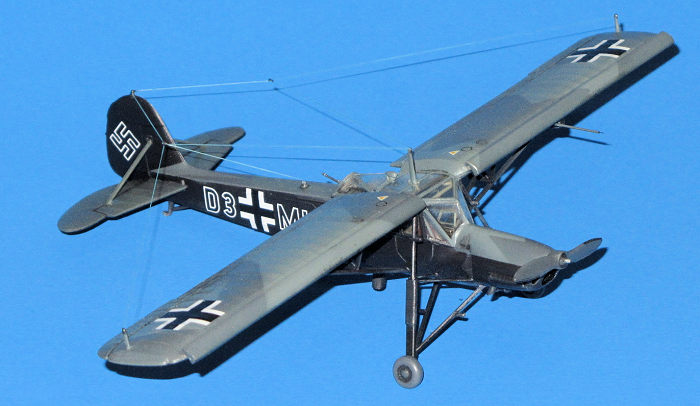 Though only a few thousand would ultimately be built, this
remarkable aircraft type was so useful for general courier,
observation, and rescue tasks that it was present everywhere the
German military was present, used by all German allies, and put
into production both in France and (in modified form) the Soviet
Union. Whenever captured, Storchs were enthusiastically pressed
into service by the Allies. Postwar, it would remain in
production both in France and the newly-reconstituted
Czechoslovakia, expanding service into Asia with France's
protracted and ugly attempt to hold on to its Indochina
territories.
Though only a few thousand would ultimately be built, this
remarkable aircraft type was so useful for general courier,
observation, and rescue tasks that it was present everywhere the
German military was present, used by all German allies, and put
into production both in France and (in modified form) the Soviet
Union. Whenever captured, Storchs were enthusiastically pressed
into service by the Allies. Postwar, it would remain in
production both in France and the newly-reconstituted
Czechoslovakia, expanding service into Asia with France's
protracted and ugly attempt to hold on to its Indochina
territories.
Back on the Eastern Front, the German Nachtschlacht units
were created in response to Soviet nighttime harassment attacks.
This new and low-tech type of attack involved low-performance
light airplanes dropping light bombloads primarily on billeting
and supply areas during the enemy's sleeping hours...the goal
being not so much to spread destruction as to cause mass panic,
disruption, and loss of sleep, so the enemy will exhibit about
the same work performance the following day as if he'd been up
all night with his diabetic child's malfunctioning blood-sugar
monitor. As there was really no effective way to defend against
these attacks, the only option for the Germans was to respond in
kind. While the Soviets pretty much stuck to the various and
numerous Polikarpov biplanes for this role, the Luftwaffe in
contrast pressed in all manner of obsolete utility and training
types for such service.
So we shouldn't be surprised that the Storch was
adapted to this mission. I was not aware of it, however, before
I ran across Owl's set and couldn't find any data about the
adaptation, but it's not difficult to think it through. With a
fabric-covered fuselage, bomb racks were probably not a viable
option for a field conversion, so a tube was let through the
lower skin from behind the rear occupant's seat for bundles of
grenades to be dropped out by the guy in the back. Funny what
wartime expediency necessitates.
I have no idea how successful the Storch was in this
role, but it's well-established that these raids did their job
for both sides very effectively for their cost. Incidentally,
there is still no easy defense against this form of attack,
unless a fighter with look-down shoot-down capability happens to
a) present overhead and is b) willing to waste an AMRAAM on such
a cheap little airplane.
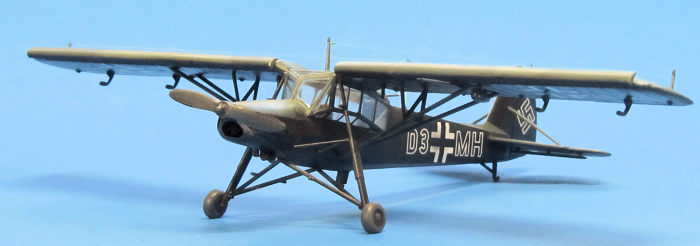 Heller obviously had a burst of inspiration in the mid-70s,
cutting molds for a wide variety of fairly obscure small
aircraft. Who would've thought in the era of Saturday Night
Fever we'd get injected kits of the SAAB J-21 and Safir, Bf-108
and early Bf-109, Cauldron Simoun, PZL P.11c and Karas, SBC
Helldiver, and so on? This kit came in with that rush. It's
since been eclipsed in 1/72 by the more refined Academy offering
but is still a worthy build. Good overall shapes [with one
exception, as described in (3) below] are provided and optional
parts for the French Morane-built version with its angled
trailing edges on the stabilizer.
Heller obviously had a burst of inspiration in the mid-70s,
cutting molds for a wide variety of fairly obscure small
aircraft. Who would've thought in the era of Saturday Night
Fever we'd get injected kits of the SAAB J-21 and Safir, Bf-108
and early Bf-109, Cauldron Simoun, PZL P.11c and Karas, SBC
Helldiver, and so on? This kit came in with that rush. It's
since been eclipsed in 1/72 by the more refined Academy offering
but is still a worthy build. Good overall shapes [with one
exception, as described in (3) below] are provided and optional
parts for the French Morane-built version with its angled
trailing edges on the stabilizer.
Mine's a Smer release. I bought it long enough ago
that the import sticker on the box says "Made in
Czechoslovakia". Rest in peace, Squadron Mail Order. You did us
some nice favors in your day.
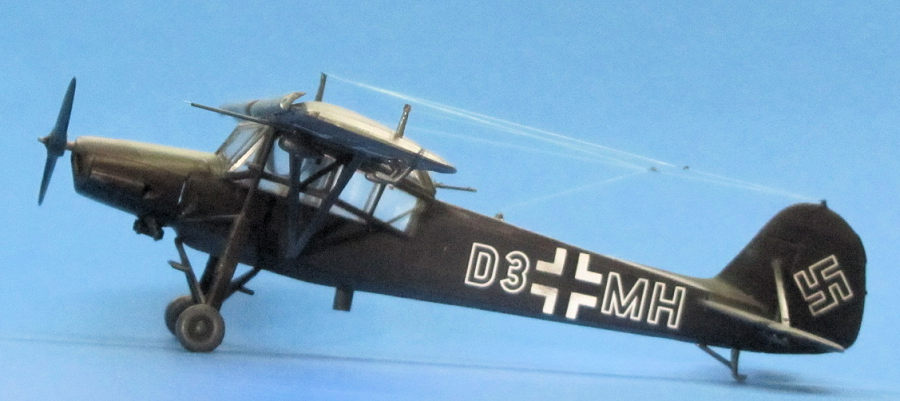

 Though only a few thousand would ultimately be built, this
remarkable aircraft type was so useful for general courier,
observation, and rescue tasks that it was present everywhere the
German military was present, used by all German allies, and put
into production both in France and (in modified form) the Soviet
Union. Whenever captured, Storchs were enthusiastically pressed
into service by the Allies. Postwar, it would remain in
production both in France and the newly-reconstituted
Czechoslovakia, expanding service into Asia with France's
protracted and ugly attempt to hold on to its Indochina
territories.
Though only a few thousand would ultimately be built, this
remarkable aircraft type was so useful for general courier,
observation, and rescue tasks that it was present everywhere the
German military was present, used by all German allies, and put
into production both in France and (in modified form) the Soviet
Union. Whenever captured, Storchs were enthusiastically pressed
into service by the Allies. Postwar, it would remain in
production both in France and the newly-reconstituted
Czechoslovakia, expanding service into Asia with France's
protracted and ugly attempt to hold on to its Indochina
territories. Heller obviously had a burst of inspiration in the mid-70s,
cutting molds for a wide variety of fairly obscure small
aircraft. Who would've thought in the era of Saturday Night
Fever we'd get injected kits of the SAAB J-21 and Safir, Bf-108
and early Bf-109, Cauldron Simoun, PZL P.11c and Karas, SBC
Helldiver, and so on? This kit came in with that rush. It's
since been eclipsed in 1/72 by the more refined Academy offering
but is still a worthy build. Good overall shapes [with one
exception, as described in (3) below] are provided and optional
parts for the French Morane-built version with its angled
trailing edges on the stabilizer.
Heller obviously had a burst of inspiration in the mid-70s,
cutting molds for a wide variety of fairly obscure small
aircraft. Who would've thought in the era of Saturday Night
Fever we'd get injected kits of the SAAB J-21 and Safir, Bf-108
and early Bf-109, Cauldron Simoun, PZL P.11c and Karas, SBC
Helldiver, and so on? This kit came in with that rush. It's
since been eclipsed in 1/72 by the more refined Academy offering
but is still a worthy build. Good overall shapes [with one
exception, as described in (3) below] are provided and optional
parts for the French Morane-built version with its angled
trailing edges on the stabilizer.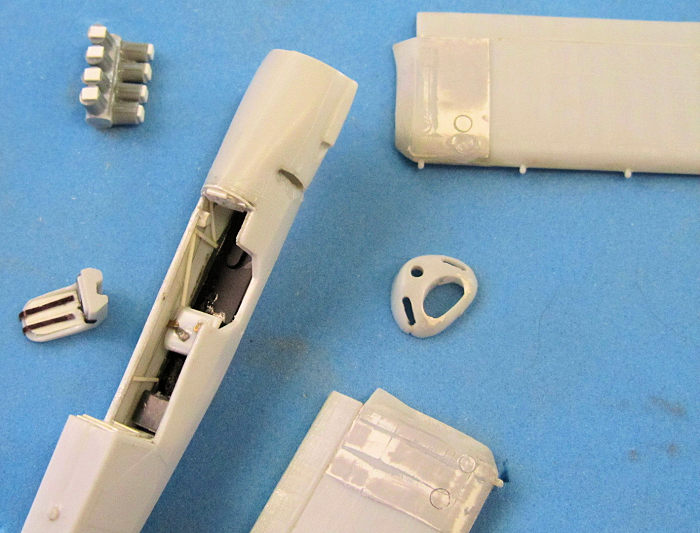 verwhelms
the sidewalls, instrument panel area, and rear bulkhead. If I were to do
another Heller Storch, I would only refine the shape of the seats and
add some belts, and replace that top framing.
verwhelms
the sidewalls, instrument panel area, and rear bulkhead. If I were to do
another Heller Storch, I would only refine the shape of the seats and
add some belts, and replace that top framing.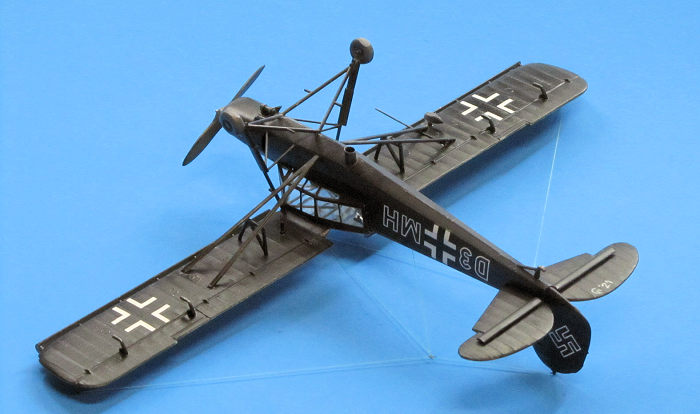 up the various vents around the cowl itself and scribed/refined the
detail in the area. Before adding the cowl front, I refined the shape of
the main cooling air opening "mouth" by putting filler into the
too-sharp corners, rounding them with brass tube while the putty was
still soft, and wet sanding it all flush when it was dry. All this
really improved and brought that prominent region of the model to life.
up the various vents around the cowl itself and scribed/refined the
detail in the area. Before adding the cowl front, I refined the shape of
the main cooling air opening "mouth" by putting filler into the
too-sharp corners, rounding them with brass tube while the putty was
still soft, and wet sanding it all flush when it was dry. All this
really improved and brought that prominent region of the model to life. 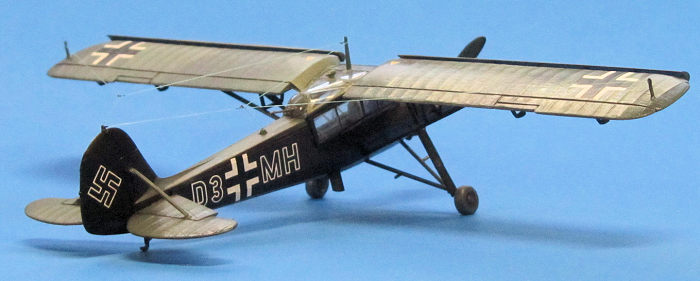 Pretty straightforward. I sprayed the undersides with a lightened black,
then followed with the RLM 70/71 topsides, masking made easy with the
German splinter scheme. This was all sealed in Future/whatever they call
it now and then the outstanding Owl decals went on without issue,
performing similarly to Superscale products. Details were painted, a
slight weathering applied with a silver dry-brushing on prominent edges,
and a semi-gloss clear sprayed on to lock it all in.
Pretty straightforward. I sprayed the undersides with a lightened black,
then followed with the RLM 70/71 topsides, masking made easy with the
German splinter scheme. This was all sealed in Future/whatever they call
it now and then the outstanding Owl decals went on without issue,
performing similarly to Superscale products. Details were painted, a
slight weathering applied with a silver dry-brushing on prominent edges,
and a semi-gloss clear sprayed on to lock it all in.